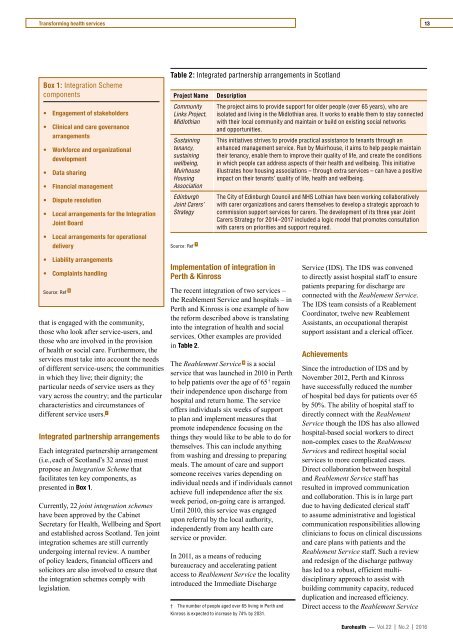EUROHEALTH
Eurohealth-volume22-number2-2016
Eurohealth-volume22-number2-2016
Create successful ePaper yourself
Turn your PDF publications into a flip-book with our unique Google optimized e-Paper software.
Transforming health services<br />
13<br />
Box 1: Integration Scheme<br />
components<br />
• Engagement of stakeholders<br />
• Clinical and care governance<br />
arrangements<br />
• Workforce and organizational<br />
development<br />
• Data sharing<br />
• Financial management<br />
• Dispute resolution<br />
• Local arrangements for the Integration<br />
Joint Board<br />
• Local arrangements for operational<br />
delivery<br />
Table 2: Integrated partnership arrangements in Scotland<br />
Project Name<br />
Community<br />
Links Project,<br />
Midlothian<br />
Sustaining<br />
tenancy,<br />
sustaining<br />
wellbeing,<br />
Muirhouse<br />
Housing<br />
Association<br />
Edinburgh<br />
Joint Carers’<br />
Strategy<br />
Source: Ref 7<br />
Description<br />
The project aims to provide support for older people (over 65 years), who are<br />
isolated and living in the Midlothian area. It works to enable them to stay connected<br />
with their local community and maintain or build on existing social networks<br />
and opportunities.<br />
This initiatives strives to provide practical assistance to tenants through an<br />
enhanced management service. Run by Muirhouse, it aims to help people maintain<br />
their tenancy, enable them to improve their quality of life, and create the conditions<br />
in which people can address aspects of their health and wellbeing. This initiative<br />
illustrates how housing associations – through extra services – can have a positive<br />
impact on their tenants’ quality of life, health and wellbeing.<br />
The City of Edinburgh Council and NHS Lothian have been working collaboratively<br />
with carer organizations and carers themselves to develop a strategic approach to<br />
commission support services for carers. The development of its three year Joint<br />
Carers Strategy for 2014 – 2017 included a logic model that promotes consultation<br />
with carers on priorities and support required.<br />
• Liability arrangements<br />
• Complaints handling<br />
Source: Ref 5<br />
that is engaged with the community,<br />
those who look after service-users, and<br />
those who are involved in the provision<br />
of health or social care. Furthermore, the<br />
services must take into account the needs<br />
of different service-users; the communities<br />
in which they live; their dignity; the<br />
particular needs of service users as they<br />
vary across the country; and the particular<br />
characteristics and circumstances of<br />
different service users. 7<br />
Integrated partnership arrangements<br />
Each integrated partnership arrangement<br />
(i.e., each of Scotland’s 32 areas) must<br />
propose an Integration Scheme that<br />
facilitates ten key components, as<br />
presented in Box 1.<br />
Currently, 22 joint integration schemes<br />
have been approved by the Cabinet<br />
Secretary for Health, Wellbeing and Sport<br />
and established across Scotland. Ten joint<br />
integration schemes are still currently<br />
undergoing internal review. A number<br />
of policy leaders, financial officers and<br />
solicitors are also involved to ensure that<br />
the integration schemes comply with<br />
legislation.<br />
Implementation of integration in<br />
Perth & Kinross<br />
The recent integration of two services –<br />
the Reablement Service and hospitals – in<br />
Perth and Kinross is one example of how<br />
the reform described above is translating<br />
into the integration of health and social<br />
services. Other examples are provided<br />
in Table 2.<br />
The Reablement Service 9 is a social<br />
service that was launched in 2010 in Perth<br />
to help patients over the age of 65 † regain<br />
their independence upon discharge from<br />
hospital and return home. The service<br />
offers individuals six weeks of support<br />
to plan and implement measures that<br />
promote independence focusing on the<br />
things they would like to be able to do for<br />
themselves. This can include anything<br />
from washing and dressing to preparing<br />
meals. The amount of care and support<br />
someone receives varies depending on<br />
individual needs and if individuals cannot<br />
achieve full independence after the six<br />
week period, on-going care is arranged.<br />
Until 2010, this service was engaged<br />
upon referral by the local authority,<br />
independently from any health care<br />
service or provider.<br />
In 2011, as a means of reducing<br />
bureaucracy and accelerating patient<br />
access to Reablement Service the locality<br />
introduced the Immediate Discharge<br />
† The number of people aged over 65 living in Perth and<br />
Kinross is expected to increase by 74% by 2031.<br />
Service (IDS). The IDS was convened<br />
to directly assist hospital staff to ensure<br />
patients preparing for discharge are<br />
connected with the Reablement Service.<br />
The IDS team consists of a Reablement<br />
Coordinator, twelve new Reablement<br />
Assistants, an occupational therapist<br />
support assistant and a clerical officer.<br />
Achievements<br />
Since the introduction of IDS and by<br />
November 2012, Perth and Kinross<br />
have successfully reduced the number<br />
of hospital bed days for patients over 65<br />
by 50%. The ability of hospital staff to<br />
directly connect with the Reablement<br />
Service though the IDS has also allowed<br />
hospital-based social workers to direct<br />
non-complex cases to the Reablement<br />
Services and redirect hospital social<br />
services to more complicated cases.<br />
Direct collaboration between hospital<br />
and Reablement Service staff has<br />
resulted in improved communication<br />
and collaboration. This is in large part<br />
due to having dedicated clerical staff<br />
to assume administrative and logistical<br />
communication responsibilities allowing<br />
clinicians to focus on clinical discussions<br />
and care plans with patients and the<br />
Reablement Service staff. Such a review<br />
and redesign of the discharge pathway<br />
has led to a robust, efficient multidisciplinary<br />
approach to assist with<br />
building community capacity, reduced<br />
duplication and increased efficiency.<br />
Direct access to the Reablement Service<br />
Eurohealth — Vol.22 | No.2 | 2016
















